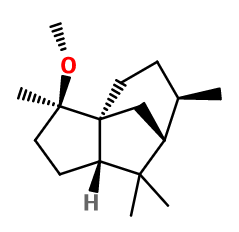
Photo credits: ScenTree SAS
| Company | Ingredient Name | ID | Comments | Naturality | Certifications | Purity | Latin name | Treated part | Geographical origin | MOQ |
|---|---|---|---|---|---|---|---|---|---|---|
|
|
Cedramber - 30 Gr | - |
Visit website
|
- | - | - | - | - | - |
General Presentation
-
CAS N° : 19870-74-7
-
EINECS number : 243-384-7
-
FEMA number : Donnée indisponible.
-
FLAVIS number : Donnée indisponible.
-
JECFA number : Donnée indisponible.
-
Appearance : Colorless liquid
-
Density : 0,975
-
Volatility : Base
-
Price Range : €€
Physico-chemical properties
-
Molecular formula : C16H28O
-
Molecular Weight : 236,4 g/mol
-
Log P : 4,6
-
Fusion Point : Donnée indisponible.
-
Boiling Point : 259°C
-
Detection Threshold : Donnée indisponible.
-
Optical rotation : Donnée indisponible
-
Vapor pressure : Donnée indisponible
-
Refractive Index @20°C : Donnée indisponible
-
Acid Value : Donnée indisponible.
-
Flash Point : 135°C
Uses
Uses in perfumery :
Cedramber® is used in men's fragrances for woody and ambery accords, and in women's fragrances for some floral notes.
Year of discovery :
Discovered in 1966.
Natural availability :
Cedramber® is not available in its natural state.
Isomerism :
Cedramber® contains several asymmetric carbons. However, only a very precise conformation is used in perfumery. Ambroxan®, Muscenone® and Sandela® are the constitutional isomers of Cedramber®. Only Ambroxan® is close by its ambergris aspect. The other two have a very different smell.
Synthesis precursor :
Cedramber® is not a precursor to the synthesis of another compound of olfactory interest.
Synthesis route :
Cedramber® is synthesized by a nucleophilic substitution of Cedrol, for example by reaction with iodomethane, in the presence of potassium carbonate. Cedrol is obtained by oxidation of Alpha-Cedrene.
Regulations & IFRA
Allergens :
This ingredient does not contain any allergen.
IFRA 51th :
This ingredient is not restricted for the 51th amendment

